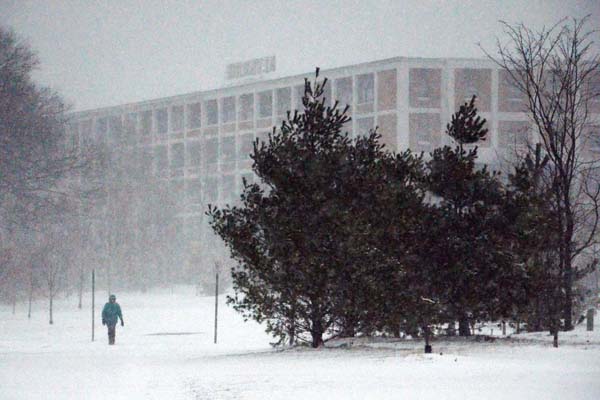January 1, 2011
 Winter Wanderland: Sunday’s snowstorm— which dumped more than one foot of snow in Boston— did not deter some from venturing onto the Neponset Greenway. Photo by Chris Lovett
Winter Wanderland: Sunday’s snowstorm— which dumped more than one foot of snow in Boston— did not deter some from venturing onto the Neponset Greenway. Photo by Chris Lovett
It was with an edge of disappointment that some readers took in the first sentence of the top story on the front page of Monday’s Boston Globe: “A Christmas weekend nor’easter barreled into New England yesterday, paralyzing airports, roadways, and even train service as it buried southern New England under wind-driven snow and as flood waters lashed the coast.”
In using so prominently that apostrophic description of the weekend near-blizzard by veteran staff member Scott Allen, and then repeating it in a Page One headline the next day, the onetime paper of record in New England signaled that it has adopted a contraction that had been proscribed in editors’ desk memos going back generations.
Pronunciation that leaves out the “r” sound is the way linguistically stubborn New Englanders and Bostonians have spoken for centuries, as in “hahbis” for harbors, “bahjis” for barges, “cahs” for cars, “Dawchestah” for Dorchester, and “nawtheastahs” for northeasters. So why nor’easter with its pointedly accented “r”?
Gerald Warner Brace, the late professor, author, and embracer of New England culture and usages, once told a Globe reporter he had no doubt that the use of “nor’easter” is an attempt “by many an outsider to adopt Coastal speech as a way of being accepted and admired.” The result, he said, is that a person “finds himself talking like a stage Yankee from a 19th-century melodrama.”
There is evidence that the contraction usage is of fairly recent coinage locally. In a column item discussing the terms earlier in the decade, Globe language maven Jan Freeman noted that “from 1975 to 1980, journalists used the ‘nor’easter’ spelling only once in five mentions of such storms; in the past year [2003], more than 80 percent of northeasters were spelled nor’easter.” It’s a good bet that most of the other 20 percent were in the Globe, which has now apparently conceded the point to the outlanders.
As things go in the final days of 2010, this lapse of sensitivity to local vernacular by a once-pre-eminent local institution – or, as others, like Ms. Freeman, might have it, this reasonable bow to the everyday evolution of word usage, adaptation, and expansion – is surely of small moment, a nod of testament to the alluring culture of the day wherein much that was saluted in the past is the enemy of the new and now.
But to some subscribers, this concession by the Globe to a blown-in affectation that makes no sense given the much-remarked-upon and often-derided “Boston accent” says something sad about the paper they grew up with. Is “snowicane” next? Probably not; that was used in the 19th century.
Obituaries and the Globe
The notion of local being meaningful seems to be utterly contrary to the Globe’s current practice of giving regular daily presentations to its readers of long, drawn-out obituaries, with multiple pictures, of New York city characters, lowercase operatives from old Broadway and Hollywood productions, and the occasional outlier who played second-biller at the Grand Ole Opry. This, while the passings of locally prominent citizens who actually had an impact on the region where the Globe circulates (the late longtime Judges Paul Murphy and Robert Prince being two that come to mind, not to leave out the death last week of the Globe’s very own longtime legendary classified ad manager, Larry Healy, who, being dead just over a week, may still have a chance) are left to the six-point type acreage of family-paid death notices.
Yes, the paper’s Bryan Marquard and Gloria Negri and the occasional intern turn out well-drawn portraits of the regional deceased (though often many days, even weeks after the subject has died), and Pulitzer Prize-winner Mark Feeney’s prepared obituary file of large-bore names is a treasure trove of insight and appreciation. And, yes, in the past the paper wasted precious space by routinely turning out obituaries that said nothing beyond what was covered in death notices just for the sake of a headline. But who is on the lookout in the newsroom each day for meritorious and timely local obituaries of less-than-epic scale?
Maybe there’s a lack of institutional knowledge about the universe of such individuals. Or maybe it’s a matter of inattention or a lack of curiosity by gatekeepers at the incoming phone-call or Fax level. Or maybe it’s simply a case of diminished staffing at a diminished Globe. Or, lastly, maybe no one at the paper thinks this is an issue.
Funeral directors whom I know – the men and women whose advertising death notices, especially on Sundays, often fill, in a single edition, as many as 24 columns (four pages) that are augmented by a remarkably minimal editorial obituary output, given the numbers of notices – have mostly stopped alerting the Globe to the deaths of prominent citizens in their communities, as have regular readers. They say that on too many occasions the suggestions aren’t followed up, or that many of the obits that do run are published too late for local mourners to get to the wakes and the funerals.
Maybe another look at the historic value of regular and timely editorial citations in its pages of the deaths of the local well-known is in order as the 138-year-old Globe continues gingerly to confront its future.
Tom Mulvoy worked in the Globe newsroom from 1966 through the year 2000.

